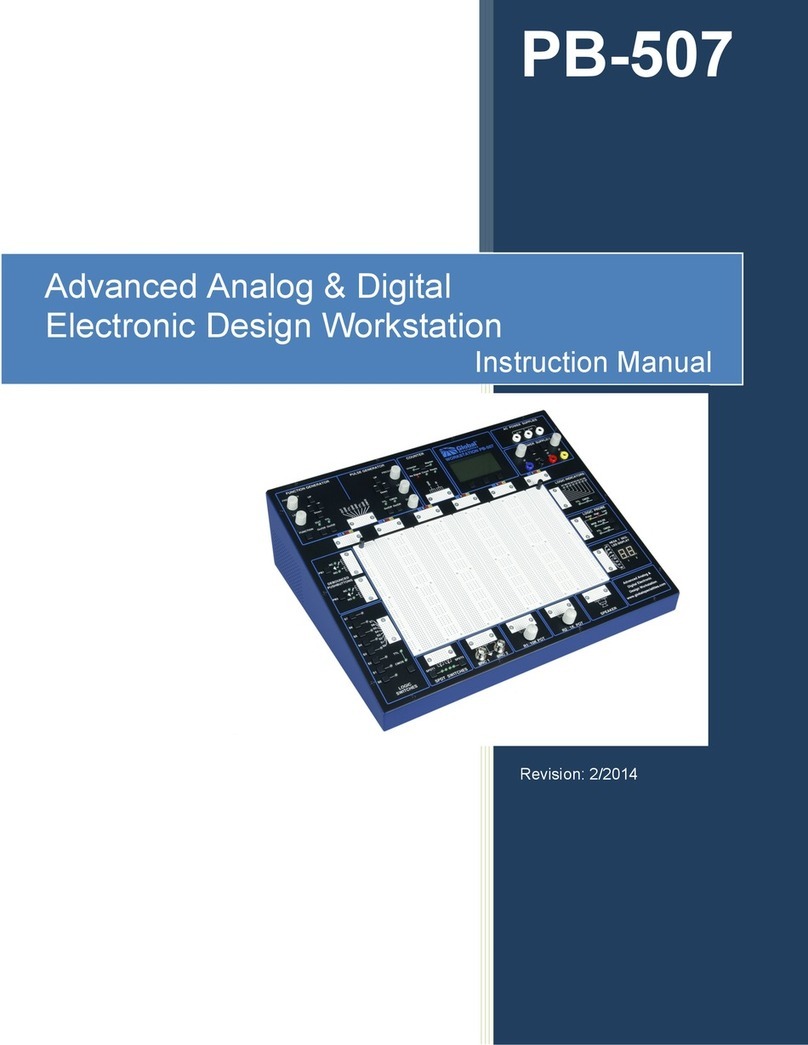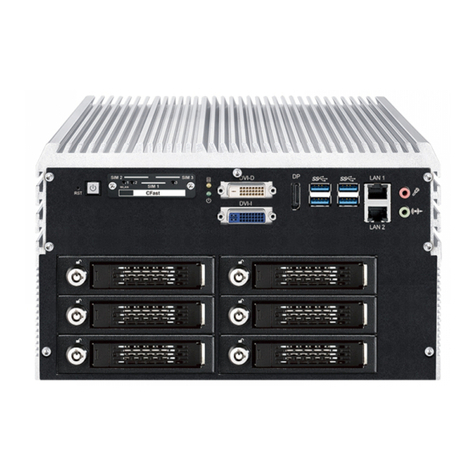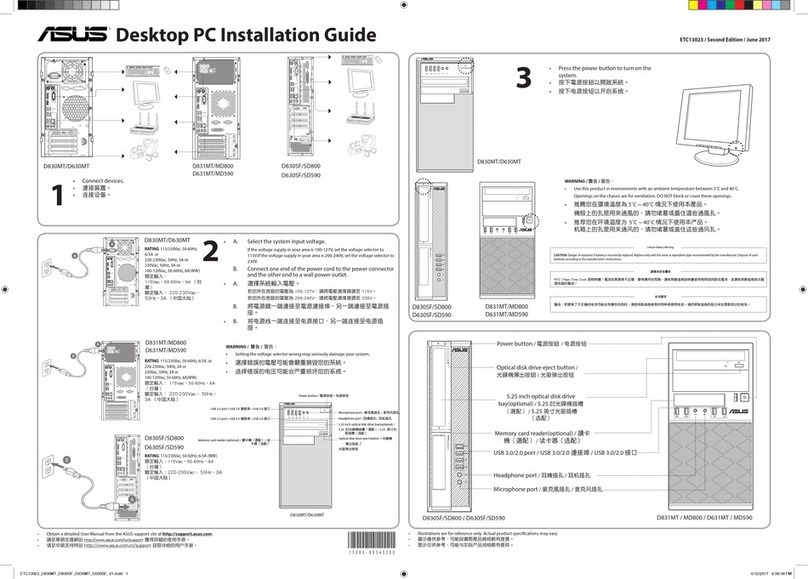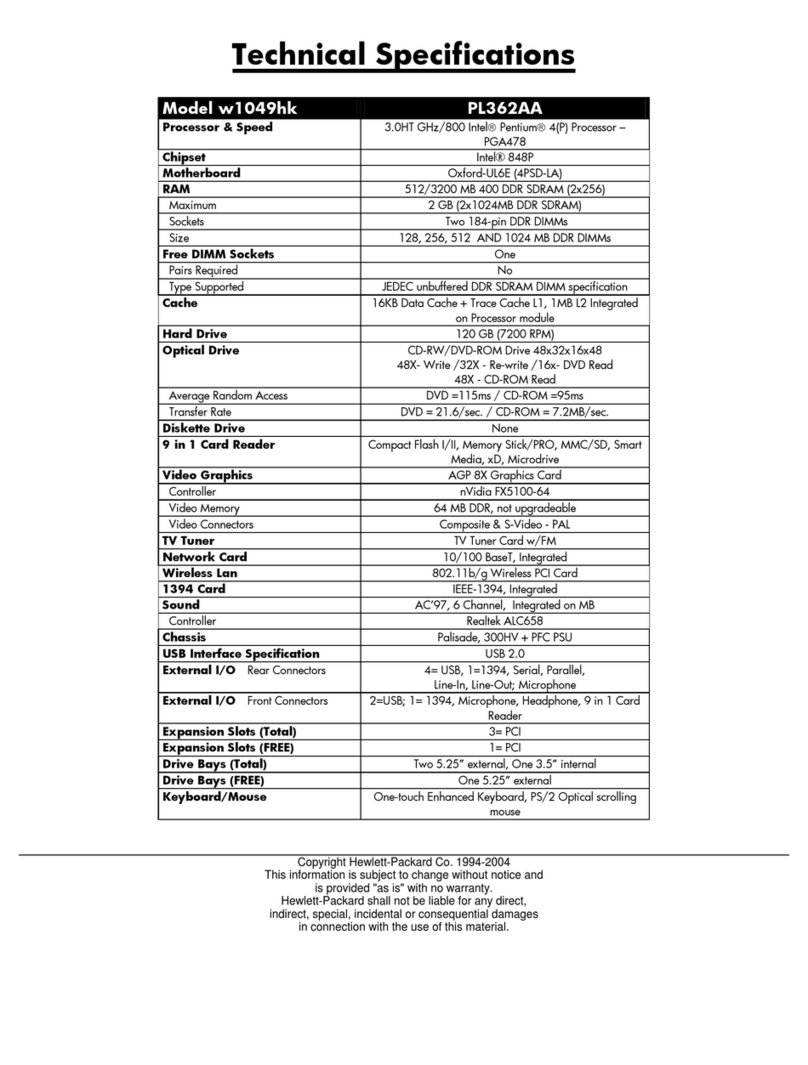Global Specialties PB-503 User manual

DESKTOP ANALOG & DIGITAL
DESIGN TRAINER
User
Manual
PB-503

1 INTRODUCTION
The PB-503 Analog/Digital Electronic Workstation is a versatile, time-saving tool
for circuit designers, engineering technicians, students, and hobbyists. A large
breadboard area and a wide choice of built-in circuit accessories allow rapid and
accurate construction of virtually any type of analog or digital circuit.
Circuit power is provided by three power supplies, two variable and one xed. The
circuit breadboard area includes over 2500 contact points. A multiple-waveform
function generator supplies sine, triangle, and square wave output for analog circuits.
A built-in speaker may be used for analog output.
Outputs also include a TTL-level square wave generator, two debounced pushbutton
switches, and a bank of eight logic switches. Eight logic indicators may be used
to display high and low logic levels. Two built-in potentiometers and two SPDT
switches are provided for circuit control and adjustment. Connections to external test
equipment or signal sources may be made using the two BNC connectors on the PB-
503.
The PB-503 eliminates the clutter and confusion that often results when constructing
sophisticated circuits. Alligator clips and similar connectors are seldom needed.
Sockets on the PB-503 allow insertion of components or wires of up to 20 gauge.
A detailed panel layout and description of the PB-503 is given in the section
“Description of Individual Features”.
2 Features & Applications
The PB-503 Analog & Digital Design Workstation is a robust electronics trainer
suitable for all levels of electronics instruction and design. Utilizing the PB-503,
students will learn valuable hands-on breadboarding techniques and build a solid
foundation in circuit experimentation, construction and analysis. Experienced
designers will nd the PB-503 an invaluable instrument, providing a reliable platform
for the most advanced and demanding design applications. The PB-503 can be used
to construct basic series and parallel circuits to the most complicated multi-stage
microcomputer circuits, incorporating the latest in industrial technology. Use the PB-
503 to construct a wide variety of experiments, including but not limited to.
zOpto-Device Circuits
zClocks
zMultivibrators
zOscillator Circuits
zTimers
zFunction Generator Circuits
zLogic Circuits

zGates
zCounters
zFlip-Flops
zAnalog-to-Digital Converters
zDigital-to-Analog Converters
zMedium Scale Integration Circuits
zPhase Lock Loops
zOperational Amplifiers
3 PB-503 COURSEWARE
Courseware is available separately through our website or as part of the PB-503LAB
package. The PB-503LAB package offers comprehensive course instruction covering
the following areas:
Electronic
Fundamentals Digital Electronics
Fundamentals of Electricity Number Systems & Codes
Ohm’s Law Binary, Decimal, Hexadecimal, Octal &
ASCII
Series Circuits Logic Gates & Boolean Algebra
Parallel Circuits Combinational Logic Circuits
Combinational Circuits Flip-Flops
Current Control Digital Arithmetic
Closed, open, shorts Counters & Registers
Switches Integrated Circuit Logic Families
Thevenin’s Theorem TTL Logic
Wheatstone Bridge MOSFETS
Capacitors CMOS
Inductors Interfacing CMOS & TTL
Phase Shift Circuits Medium Scale Integration

Impedance Decoders
Resonant Circuits Encoders
Transformers Data Conversion & Acquisition
Rectiers & Filtering Microcomputer Concepts
Integrated Circuits
Transistor Ampliers
Oscillators
Power Control Circuits
4 DESCRIPTION OF INDIVIDUAL FEATURES
In order to properly use the full capabilities of the PB-503, it is highly recommended
that the user become familiar with the panel layout and the features of the
components. See Figure 1.
Figure 1 PB-503 Components

4.1 AC Line Input
The PB-503 can run off of 115 or 230 VAC. The unit comes standard with a fuse for
115 VAC. In order to use with 230 VAC, please slide the switch on back to 230 V. You
will also need to replace the fuse with a 5 x 20 mm time lag fuse that is rated at 0.25 A
and 250 V (not included).
4.2 Power Supplies
By combining the three DC power supplies on the PB-503, the user may work with
virtually any type of integrated circuit or discrete component. The xed 5 volt supply
has become an industry standard for powering digital IC’s. IC’s which require +5
V, +12 V, and -5 V are easily accommodated by the PB-503. The variable supply
output voltages may be changed by using the screwdriver adjustment on the front
panel. The positive and negative outputs are continuously variable from +1.3 to +15
volts and -1.3 to -15 volts respectively. Both variable supply outputs are referenced
to circuit common. This creates a split supply which is often used with differential
and operational ampliers (op amps). The adjustments are recessed to prevent
inadvertent voltage changes which could be destructive to a circuit.
In addition to the DC power supplies, the PB-503 also provides a 12.6 volt center-
tapped AC supply. This allows the user to construct any of a variety of half-wave and
full-wave rectied power supplies on the breadboarding area and apply power by
simply connecting jumper wires to the three AC supply output pins.
4.3 Function Generator
The multi-waveform function generator provides continuously variable frequency
signals from 0.1 Hz (for extra-low frequency work) to radio frequency signals of 100
KHz. The frequency is selected in six decade ranges, with a slide potentiometer to
adjust frequency within each range. The sine wave output is factory adjusted for
minimum distortion. The triangle waveform is adjusted for best linearity. The standard
square wave and TTL level outputs are both set at a 5 0% duty cycle. The TTL output,
capable of driving up to 10 TTL loads, is continuously available for the square wave
output and is in phase with it.. The low output impedance of the sine, square, and
triangle waveforms (600 Ω) assures maximum coupling of the output signal to the
device being driven. All outputs can withstand a continuous short circuit to ground.
4.4 Logic Indicators
Sixteen LEDs, eight red and eight green, make up eight Logic Indicators that will
display logic high and low conditions based on either TTL or CMOS thresholds,
selectable by the user. Operating voltage can also be selected by the user to be either
at +5 volts, or at the setting of the 1.3 - 15 volts +V supply. This selection should be
the same as the operating circuitry that is to be monitored. The red LEDs will light
when the voltages at the inputs are 2.2 volts or higher when in the TTL position, or

70% of the operating voltage or higher when in the CMOS position. The green LEDs
will light when the voltages at the inputs are 0.8 volts or less when in the TTL position,
or 3 0% of the operating voltage or less when in the CMOS position. An unconnected
input, or an input not at a valid logic level, will cause both LEDs to be extinguished.
Note that the thresholds determined by the TTL positions are only accurate when
the +5 volt range is selected. The 100KΩ input impedance ensures minimal loading
effects of the circuit under test.
4.5 Debounced Pushbuttons (Pulsers)
The PB-503 uses clocked ip-ops to provide debounced pushbutton switch functions.
The pushbutton circuitry has open-collector outputs which can sink up to 250 mA
each. This type of debouncing gives the user a sharp, glitch-free trigger source which
assures reliable operation in digital circuits. Each pushbutton has a normally-open
and a normally-closed output. If necessary, a pull-up resistor can connect any pulser
output to any of the positive voltage sources.
4.6 Potentiometers
Two potentiometers are provided on the PB-503. The resistance values chosen
(1KΩ and 10KΩ) may be used in common circuit applications such as volume
controls, DC offset controls for op amps, and timing circuit controls. All leads for both
potentiometers are available and uncommitted.
4.7 BNC Connectors
The PB-503 may be connected to other pieces of equipment via two BNC connectors.
This allows the use of shielded cable to minimize noise and interference.
4.8 Switches
Two single pole, double throw (SPDT) switches are provided for general switching
functions. All leads are available and clearly marked on the PB-503 for easy
connection. Eight switches are congured as Logic Switches to provide a convenient
source of digital outputs. These switches will provide logic levels of zero volts (ground)
for a logic low, and logic high levels of either +5 volts or the voltage setting of the 1.3
-15 volt +V supply. The high level is determined by the setting of the +5/+V switch.
This arrangement makes connecting special digital circuitry such as an eight-bit input
port quick and easy, and allows compatibility with virtually any logic family.
CAUTION
Integrated circuits can be destroyed if a voltage is applied to their inputs that is higher
than the operating voltage of the ICs. Always insure that the setting of the +5/+V high-
level switch is in the correct position before making connections to any device.

5 SPECIFICATIONS
Description Specication
AC Line Input 115 VAC @ 60Hz or 230 VAC @ 50 Hz
(switchable)
Power Supplies
Fixed DC: +5 VDC 1.0 A max, current limited
Ripple <5 mV
Variable DC: +1.3V @ 150 mA to +15 VDC @
500 mA
Ripple <5 mV
Variable DC: -1.3 VDC @ 150 mA to -15 VDC @
500mA
Ripple <±5 mV
Binding Posts (4) Ground, +5VDC, Variable ±VDC Power Supply
Outputs
Pulsers
(2) Pushbutton-operated, open-collector output
pulsers. Each with 1 normally-open, 1 normally-
closed output. Each output can sink up to 250 mA.
Function Generator
Frequency Range: 0.1 Hz
to 100 kHz in six ranges
Output Voltage: 0 to +10Vp-p into 50 Ω Load
(20Vp-p in open circuit), short circuit protected
Output Impedance: 600 Ω except TTL
Output waveforms: Sine, Square,Triangle & TTL
Sine Wave Distortion: <3% @ 1 khz typical
TTL Pulse: Rise & fall time <25 ns,
drive 100 TTL Loads
Square Wave: Rise and fall times <0.5 µs
Logic Switches
(8) Logic Switches select
Logic High and Logic Low
Logic Low Level: Ground
Logic High Level: Switchable between +5 V and
the variable positive power supplies.
Switches (2) Single Pull Double Throw (SPDT) -
uncommitted

Logic Indicators
LEDs: 16 LEDs; (8) red to indicate logic high and
(8) green to indicate logic low
Logic High Threshold: 2.2 V (nominal) in TTL/+5
V mode, 70% (nominal) of selected operating
voltage in CMOS mode
Logic Low Threshold: 0.8V (nominal) in TTL/+5
V mode, 30% (nominal) of selected operating
voltage in CMOS mode
Connectors (2) BNC - uncommitted
Potentiometers (2) 1 kΩ and 10 kΩ - uncommitted
Speaker 8 Ω, 0.25 W - uncommitted
Breadboards
Removable Plexiglas Socket Plate (PB-3) with
2520 tie-points with 200 additional bus strip
tie-points internally connected to power supply
outputs and ground
Weight 7 lbs
Dimensions 6.5” x 16” x 11.5”
6 CHECKING OUT THE PB-503
The PB-503 may be checked out for proper operation by making a few simple
measurements and connections. Begin by connecting the AC line cord to a suitable
receptacle. The AC power indicator should light when the power switch is turned on.
Using a DC voltmeter, check for +5 volts between the ground terminal and the +5
volt terminal. Repeat the measurement for the positive (+) variable supply terminal
and the negative (-) variable supply terminal. Check the variability of each supply by
turning the appropriate adjusting screw. To test the logic indicators, switch the +5/+V
operating voltage switch to the +5 position. The TTL/CMOS threshold switch can be
in either position. With no input to the logic indicators, all LEDs should be turned off.
Connect one end of a jumper wire to the + 5 volt terminal and the other end to logic
indicator 1; the red LED of logic indicator 1 should light. Repeat this test for logic
indicators 2 through 8. Disconnect the jumper from the +5 volt terminal and connect
it to the ground terminal. Connect the other end to logic indicator 1; the green LED of
logic indicator 1 should light. Repeat this test for logic indicators 2 through 8.
The function generator may be tested by connecting its output to one of the speaker

inputs. Connect the other speaker input to the ground terminal (or one of the
connectors on the ground bus strip). Switch the function generator range switch to
“1” and the Hz/kHz switch to “kHz”. Move the frequency control all the way to the top.
Move the amplitude control upward until you hear a tone coming from the speaker.
Switch the waveform selector to select sine, square, and triangle. A changing but
clearly audible tone should be heard in each position. Changing the position of the
frequency control should vary the pitch of the tone.
If an oscilloscope is available, you may check the function generator for proper
waveform and frequency using standard measurement techniques.
The debounced pushbuttons can be checked by connecting one side of a resistor
(20Ω to 100 KΩ) to +5 volts and the other side to PB1-1, the NC point. Then connect
PB1-1 to LED-1 with the Logic Indicator +5/+V switch in the +5 position, the red
LED should light when PB1 is pressed and the green LED should light when PB1 is
released. Next, move the connections from PB1-1 to PB1-2, the NO point. Now the
red LED should be lit when PB1 is not pressed, and the green LED should be lit when
PB1 is pressed. Repeat these steps to test PB2.
The logic switches can be tested by connecting the output of logic switches 1 through
8 to the input of logic indicators 1 through 8. Switch the logic switch +5V/+V high
level switch to +5, and switch the logic indicator +5/+V operating voltage switch to +5.
Select the CMOS position on the logic indicator TTL/CMOS threshold select switch.
Now the logic indicators should reect the conditions of the logic switches, that is, red
LEDs will indicate switches in the high (logic “1”) position and green LEDs will indicate
switches in the low (logic “0”) position. Move each switch between its high and low
position to verify proper functioning. Switch the logic switch +5/+V high level switch
to +V and the logic indicator +5/+V operating voltage switch to +V; the relationship
between the switch positions and the logic indicator display should remain the same,
regardless of the setting of the 1.3 - 15 volts +V supply.
By using an ohmmeter, you can check the potentiometers. To do so, select an
appropriate range for measuring 10 KΩ and connect the ohmmeter leads to R1-1
and R1-2. With R1 rotated fully counterclockwise a reading of 0Ω ohms should be
observed. As the potentiometer is rotated clockwise, the resistance reading will be
seen to increase linearly up to 10 KΩ ± 20%. Now move the ohmmeter lead from R1-l
to R1-3; with R1 fully clockwise the ohmmeter will read zero ohms, and the resistance
will increase linearly to the full value noted previously as the potentiometer is rotated
counterclockwise. Select an ohmmeter range appropriate for 1 KΩ and repeat these
steps on R2 to verify its function.
To test SPDT switch S9, put S9 in the up position and connect an ohmmeter to S9-1
and S9-2. The ohmmeter should read 0 Ω. When the switch is brought to the down
position, an open circuit should be indicated. Move the ohmmeter lead from S9-1 to
S9-3 and observe a short circuit with S9 down, and an open with S9 up. These steps
can be repeated on S10 to test its functions.

7 BREADBOARDING TECHNIQUES
This section contains information which may prove useful when constructing circuits
using the PB-503. While there are no hard and fast rules for breadboarding, the
following tips may save time and trouble.
Unless a circuit is being prepared for a demonstration or display, avoid cutting
component leads very short. While short wires and leads may look neat, the clipped
components will only t into a limited “span” of connector sockets, limiting the use
of the component. It is perfectly permissible to use untrimmed components while
exploring different circuit possibilities. The only time short leads may be necessary
is when operating at higher frequencies and experiencing mysterious malfunctions.
Sometimes the only way to correct high frequency circuit problems is to shorten all
circuit connections.
Be cautious when using components which have been removed from a tape reel
used in automatic insertion equipment. Suppliers of surplus components often sell
components which are taped together in small batches. Removing the components
from the tape does not always remove the adhesive from the leads of the
components. Placing a formerly taped component into a socket connector may result
in a poor electrical connection and, worse still, leave tape adhesive in the socket.
Avoid this problem by either carefully cleaning taped component leads, clipping the
taped portion of the lead off, or avoiding the use of taped components altogether.
Be especially careful when inserting integrated circuits into the breadboard sockets.
Unless the IC pins are straight, it is very easy to crush the pin into a zigzag shape or
fold the pins underneath the body of the IC. Either way the result is a bad connection
or no connection at all.
Always use solid wire for breadboard connections. When stripping the wire ends, be
careful not to strip more than about three-eighths of an inch of insulation from the
wire. Too much bare wire may result in unintentional connections near the wire end.
After you have built up a few circuits, you will have a good collection of pre-stripped
jumper wires. Save them. By reusing these wires, you can save even more time
and effort in assembling future circuits. Pre-formed wires in various sizes are also
available from Global Specialties (please visit web site for available options and
accessories).
8 Service and Warranty Information
8.1 Limited Three-Year Warranty
Cal Test Electronics warrants this product to be free from defective material or
workmanship for a period of 3 years from the date of original purchase. Under
this warranty, Cal Test Electronics is limited to repairing the defective device when
returned to the factory, shipping charges prepaid, within the warranty period.

Units returned to Cal Test Electronics that have been subject to abuse, misuse,
damage or accident, or have been connected, installed or adjusted contrary to
the instructions furnished by Cal Test Electronics, or that have been repaired by
unauthorized persons, will not be covered by this warranty.
Cal Test Electronics reserves the right to discontinue models, change specications,
price, or design of this device at any time without notice and without incurring any
obligation whatsoever.
The purchaser agrees to assume all liabilities for any damages and/or bodily
injury which may result from the use or misuse of this device by the purchaser, his
employees, or agents.
This warranty is in lieu of all other representations or warranties expressed or implied
and no agent or representative of Cal Test Electronics is authorized to assume any
other obligation in connection with the sale and purchase of this device.
8.2 Calibration and Repair
If you have a need for any calibration or repair services, please visit us on the web at:
globalspecialties.com. See the “Service” tab. Or contact us via the “Contact” tab. You
may also contact us at:
Global Specialties®
(A Cal Test Electronics Company)
22820 Savi Ranch Parkway
Yorba Linda, CA 92887
800-572-1028 or 714-221-9330
globalspecialties.com
© Cal Test Electronics 2016
All rights reserved. No Part of this book shall be reproduced, stored in a retrieval
system, or transmitted by any means, electronic, mechanical, photocopying recording,
or otherwise, without written permission from Cal Test Electronics.

20160712
This manual suits for next models
1
Table of contents
Other Global Specialties Desktop manuals



















